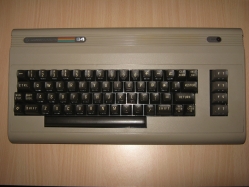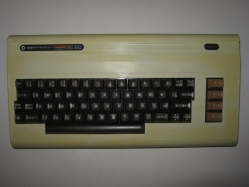New Donation: Commodore VC-1541 to Repair + Klain Tape + Some IC.
Material donated:
- Commodore VC-1541 (need to fix it)
- Microcomputer Data Recorder Klain for Commodore 64/VIC20/PET.
- Some IC.
Thanks Alessio for the donation.
Material donated:
Thanks Alessio for the donation.
Today a friend has donated to me some nice things. Thanks Damiano (Manosoft).
Things that have been donated:
Today a friend has donated to me some nice things. Thanks Damiano (Manosoft).
Things that have been donated:
I have found a Commodore 64 / 1541 Floppy Drive and a C16 Datassette in the trash.
The Floppy Drive was very dirty but in good working state, while the Commodore 64 was faulty (black screen with tiny raster effect). I have replaced the video chip (MOS 6569) and is back to run better than never.
This is a rare SIO Adapter cable. You can use it for connect the Atari 1010 Program Recorder on Commodore 64/128.

Autopsy:
Today i picked up a Commodore 64 in good working condition with Powersupply / RF Cable, Commodore 16 Datassette and a Suncom TAC2.

Autopsy:
from Wikipedia:
The VIC-20 (Germany: VC-20; Japan: VIC-1001) is an 8-bit home computer which was sold by Commodore Business Machines. The VIC-20 was announced in 1980, roughly three years after Commodore’s first personal computer, the PET. The VIC-20 was the first computer of any description to sell one million units.
The VIC-20 was intended to be more economical than the PET computer. It was equipped with only 5 KB of RAM (of this, only 3583 Bytes were available to the user) and used the same MOS 6502 CPU as the PET. The VIC-20′s video chip, the MOS Technology VIC, was a general-purpose color video chip designed by Al Charpentier in 1977 and intended for use in inexpensive display terminals and game consoles, but Commodore couldn’t find a market for the chip. As the Apple II gained momentum with the advent of VisiCalc in 1979, Jack Tramiel wanted a product that would compete in the same segment, to be presented at the January 1980 CES. For this reason Chuck Peddle and Bill Seiler started to design a computer named TOI (The Other Intellect).
The TOI computer failed to materialize, mostly due to the fact that it required an 80-column character display which in turn required the MOS Technology 6564 chip. However, the chip could not be used in the TOI since it required very expensive static RAM to operate fast enough. In the meantime, freshman engineer Robert Yannes at MOS Technology (then a part of Commodore) had designed a computer in his home dubbed the MicroPET and finished a prototype with some help from Al Charpentier and Charles Winterble.
With the TOI unfinished, when Jack Tramiel was confronted with the MicroPET prototype, he immediately said he wanted it to be finished and ordered it to be mass-produced following a limited demonstration at the CES.
source: wikipedia
Autopsy:
Description:
from Wikipedia:
The Commodore 1530 (C2N) Datasette, was Commodore’s dedicated computer tape recorder.
It provided access to an inexpensive storage medium for Commodore’s 8-bit home/personal computers, notably the PET, VIC-20, and C64. A physically similar model Commodore 1531 was made for the Commodore 16 and Plus/4 series computers.
The Datasette contained built-in analog to digital converters and audio filters to convert the computer’s digital information into analog sound and vice versa (much like a modem does over a telephone line). Connection to the computer was done via a proprietary edge connector (Commodore 1530) or mini-DIN connector (Commodore 1531). The absence of recordable audio signals on this interface made the Datasette and its few clones the only cassette recorders usable with CBM’s machines, until aftermarket converters made the use of ordinary recorders possible.
source: wikipedia
Autopsy:
Description:
from Wikipedia:
The Commodore 1530 (C2N) Datasette (a portmanteau of data and cassette), was Commodore’s dedicated computer tape recorder.
It provided access to an inexpensive storage medium for Commodore’s 8-bit home/personal computers, notably the PET, VIC-20, and C64. A physically similar model Commodore 1531 was made for the Commodore 16 and Plus/4 series computers.
source: Wikipedia
Recent Comments